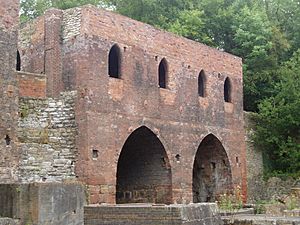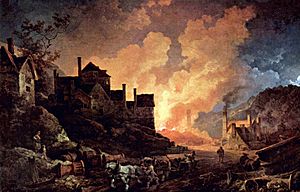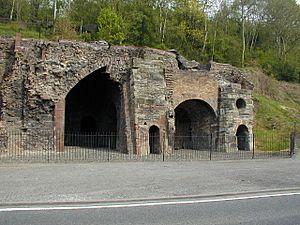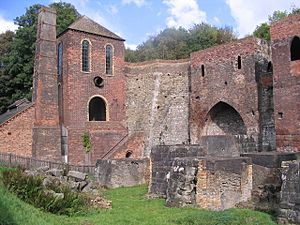Madeley Wood Company facts for kids
The Madeley Wood Company was a big company that started in 1756. It was formed when the Madeley Wood Furnaces were built. These furnaces were also called Bedlam Furnaces. They were located right next to the River Severn, about a mile west of Blists Hill.
Contents
Bedlam Furnaces: A Look Back
The Madeley Wood Furnaces, or Bedlam Furnaces, belonged to this company. The company had special permission to dig for coal and iron ore in the Madeley area.
In 1776, Abraham Darby III from the Coalbrookdale Company took over these works. Later, in 1797, the Madeley Wood Works became a separate company again. It was run by the Reynolds family, who had worked with the Darby family since the 1760s. They also worked with the Ketley Ironworks.
After Joseph Reynolds decided to focus on his bank, the Anstice family took over the Madeley Wood Company. One of them had already been managing the works. Their business then became another Madeley Wood Company.
Why "Bedlam" Furnaces?
The name Bedlam Furnaces might have come from paintings. In 1803, an artist named John Sell Cotman painted the furnace. He called his painting Bedlam Furnace Near Irongate, Shropshire. Another artist, Paul Sandby Munn, also painted the same place. He called his painting Bedlam Furnace, Madeley Dale, Shropshire.
The artists thought the place looked like a "lunatic asylum," which was a hospital for people with mental illnesses. "Bedlam" was a common word for such a place. It was also a joke about Fletcher of Madeley, a famous Methodist preacher. The ironworks were in his church area. Another painter, Edward Dayes, also painted the furnaces around the same time. His painting is now in the Tate Gallery.
Restoring the Furnaces
Not much was known about the site in the 1900s. Lots of plants grew over the ruins. Then, in the late 1950s, the site was used to dump waste, which completely buried the furnace bases.
In the 1970s, the Ironbridge Gorge Museum Trust started to clear and restore the works. They helped bring this important historical site back to life.
Blists Hill: Iron Production
When the ironworks at Blists Hill opened in 1790, they had a great location. The Shropshire Canal ran right next to the site. This meant it was easy to get raw materials and ship out the finished products. Because of this, the company decided to build a blast furnace at Blists Hill in 1832.

More furnaces were added in 1840 and 1844, making a total of three. The site kept making pig iron until 1912. That's when the ironworks stopped production after two of the furnaces were shut down.
Today, the furnace buildings and blowing houses are still there. They are kept as part of the Blists Hill Victorian Town. This is one of the amazing Ironbridge Gorge Museums.




